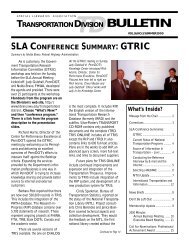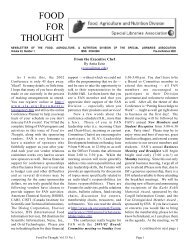Education Libraries - Special Libraries Association
Education Libraries - Special Libraries Association
Education Libraries - Special Libraries Association
You also want an ePaper? Increase the reach of your titles
YUMPU automatically turns print PDFs into web optimized ePapers that Google loves.
Photo Identity Crisis: Creating a Classification and Organization Method<br />
for Unidentified Photographic Archives<br />
By Heidi Blackburn, Pam Bower, and Alysia Starkey<br />
Abstract<br />
Institutional archives have always provided a sense of history and unity for most<br />
universities. This is especially emphasized for the Kansas State University at Salina<br />
photographic collection. The school has gone through four different name changes in<br />
the last fifty years and the library has amassed an overwhelming assortment of<br />
photographs documenting various events on campus, from groundbreaking ceremonies to<br />
Information &<br />
Media Literacy<br />
student social occasions. With an estimated total of over 11,000 unlabeled photographs, the K-State at Salina<br />
librarians have worked hard to begin the process of providing the university community with a useful<br />
resource for historical research in the future.<br />
Introduction<br />
The focus of this paper is the pictorial collection<br />
of nearly 11,000 items in the Kansas State<br />
University (K-State) at Salina archives. Candid<br />
photographs make up the greater part of the<br />
collection and document momentous historical<br />
events throughout the life of the college. However,<br />
the majority of the collection was never labeled<br />
with names, dates, and location information,<br />
which has rendered the collection virtually<br />
impossible to catalog or use. The collection plays<br />
a central role in preserving the diverse history of<br />
K-State at Salina. It should also be noted the<br />
materials contained in this collection do not<br />
include activities which took place on the main<br />
campus of Kansas State University. The Hale<br />
Library <strong>Special</strong> Collections department, located in<br />
Manhattan, Kansas, is in charge of preserving<br />
those artifacts in the University Archives and<br />
Manuscripts collection. K-State Salina library staff<br />
have recently begun taking comprehensive<br />
measures to maintain the integrity of this unique<br />
collection.<br />
The storage of photographs,<br />
documents and other<br />
historical material is not a<br />
new concept. It could be<br />
considered an innate human<br />
need to leave a legacy; to<br />
prove “I was here and this is<br />
what I accomplished.”<br />
Archival documents are the<br />
tapestry that provides future<br />
generations meaning into<br />
how things came to be.<br />
Would the telling of history be as powerful<br />
without photographs of Anne Frank’s attic or<br />
those of Martin Luther King Jr.’s March on<br />
Washington in which to associate these events?<br />
The K-State at Salina Library’s photographic<br />
archival collection serves as the medium for which<br />
future students, faculty and administrators will<br />
connect with the past. Literature was reviewed<br />
prior to the project inception to ensure best<br />
practices were applied during the selection and<br />
organization of materials. This section provides a<br />
brief overview of these findings.<br />
Archival collections in libraries and museums<br />
exist to fill a need in the society for which they<br />
serve. An archival collection is an important<br />
component to an institution. It provides a<br />
comprehensive record and measure of the<br />
institution’s “importance to the public and their<br />
influence on society” (Ostby, 2006). More<br />
specifically, photographs play a critical role in<br />
documenting a library or<br />
museum’s value and bearing<br />
on society.<br />
The Impact of Photographic<br />
Archival Collections<br />
Most photographic archival<br />
collections are acquired<br />
through in-house production.<br />
Berinstein (1998) states, “Inhouse<br />
personnel may generate<br />
the pictures the library<br />
collects, either by creating<br />
them, donating them, or both.”<br />
<strong>Education</strong> <strong>Libraries</strong>, Volume 31, No. 2, Winter 2008 31

















